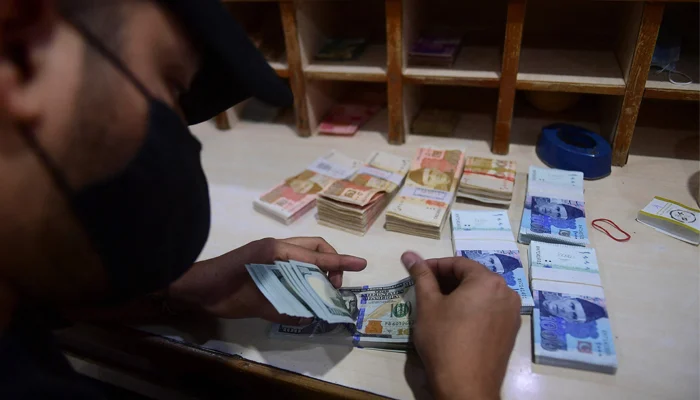- Market sources say no shortage of dollars due to good inflows.
- Commercial banks working like a cartel, reveal intel sources.
- Say banks jack up inter-bank dollar rate to maximise profits.
ISLAMABAD: The recent two-day decline in the price of rupee against the dollar, which has now reversed, was allegedly due to manipulation by certain banks, reported The News on Friday.
On Thursday, the rupee turned the tide against the dollar and strengthened in inter-bank and open markets simultaneously with clear-cut margins but there was no apparent change in the fundamentals of market forces.
The reversal shows that the decline in the rupee’s value was due to the connivance of certain commercial banks that were instrumental in manipulating the currency market to maximise their benefits and profiteering.
In the past, the banking sector’s profits ballooned without any repercussions or being burdened with windfall gains tax after they managed to foil all such attempts made by the authorities.
However, intelligence sources told The News that the commercial banks, along with other stakeholders, were working like a cartel. They added that the banks jack up the inter-bank dollar rate to maximise their profits on lined-up Letter of Credits (LCs) of importers and deliberately delay LCs to create an artificial shortage of greenback in the market and raising the interbank dollar rate to Rs282.
Following a hue and cry by importers and other stakeholders, the banks blamed the upcoming payment of installment to the International Monetary Fund (IMF) by the government in November for the dollar’s increase.
But market sources told The News that there was no shortage of dollars in the market as money changers are getting good inflows.
Therefore, the banks accumulated USD at 276/277 and then raised the interbank rate to over 280 to earn profits. The market stakeholders claim that banks usually resort to these sorts of tactics to offset the losses incurred due to continued depreciation in the price of dollars.
Exchange Companies Association of Pakistan (ECAP) Chairman Malik Bostan, when questioned about the issue, laid the blame on the manipulation under which efforts were made to convert all benefits into losses by creating a new wave of the weakness of the rupee against the dollar and it was conveyed to high-ups.
Bostan said that the rupee recovered on Thursday and is hopeful of seeing the trend continue in the coming days as well.
Zafar Paracha, ECAP ‘s general secretary, agreed with Bostan’s assessment of alleged manipulation by banks. He added that proper actions taken by the relevant authorities led to the improvement of rupee-dollar parity in both interbank and open markets.
Meanwhile, independent economists argue the government took administrative steps in the right direction, which yielded positive results. However, they warned that the sustainability of those gains is dependent on the economic managers’ ability to generate dollar inflows to get Pakistan out of the dollar liquidity crunch.
Pakistan, they said, would have to repay around $790 million as debt servicing of foreign loans, including principal and mark-up repayments. Out of this, the government had repaid the Euro bond interest repayment in recent weeks.
Now the government is also bound to repay $187 million as principal and markup amount in the current month, so the dollar inflows need to be improved in order to stabilise the currency market on a sustained basis.

 Latest News1 day ago
Latest News1 day ago
 Latest News2 days ago
Latest News2 days ago
 Latest News1 day ago
Latest News1 day ago
 Business2 days ago
Business2 days ago
 Latest News2 days ago
Latest News2 days ago
 Business2 days ago
Business2 days ago
 Latest News1 day ago
Latest News1 day ago
 Latest News2 days ago
Latest News2 days ago






















